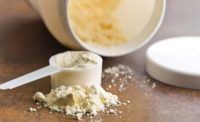
Slow churning kneads fat molecules at a colder temperature, making lower-fat ice creams taste more like regular ice cream. The new process boosted sales of reduced-fat ice creams by 75% in 2005. But using slow-churn technology involves a substantial investment in equipment and licensing of proprietary technology, and at least one manufacturer has found that adding whey protein isolate and adjusting the stabilizer mix can produce similar results with lower costs.
At the International Whey Conference in Paris last fall, Sam Adapa, product development manager for Safeway, Walnut Creek, Calif., explained that his company chose to use a combination of whey protein isolate and a unique blend of stabilizers and emulsifiers in its light ice cream. Adapa noted that Safeway’s ingredient approach did not require the company to invest in expensive equipment and licensing, and had broad applications across a range of ice cream products from low fat to full fat.
American consumers still fight the battle of the bulge and continue to look for permissible indulgence foods such as light ice cream. The requirements for a “light” or “lite” claim are outlined in CFR §101.56. Safeway Select Churned Rich and Creamy light ice cream contains 5% to 6% butterfat, compared with a 10% minimum for standard ice cream. The label of its Cookies and Cream variety declares 3.5 grams of fat and 120 calories versus 13 grams of fat and 220 calories for regular ice cream.
Whey proteins also add a variety of textural improvements to ice cream, Adapa says, including additional stability and viscosity to the ice cream mix. Whey proteins also bind water to help reduce ice crystal growth and improve eating quality and mouthfeel. Adapa noted that increased overrun did not negatively impact the mouthfeel and texture of ingredient-based Churned Rich and Creamy ice cream.
Supermarket data from IRI for 2008 shows that in the almost $4 billion sales of ice cream, branded full-fat products still dominate the category with about 62% of sales.1 Branded reduced-fat ice cream sales eased off a bit in 2008, but still account for more than $500 million. Sales of branded fat-free ice cream have increased, although this segment accounts for just above 1% of total ice cream sales.
Another significant supermarket segment is frozen novelties, which reached nearly $2.5 billion in 2008. Safeway noted frozen novelties as an area for further expansion in 2009.
Novelties with whey
While the Safeway approach uses a modest level of whey protein, other companies are exploring frozen novelties with much higher levels of whey protein. “The technology exists to produce frozen novelties with 10 to 20 grams of whey protein per serving,” explains Phil Rakes, application specialist, Main Street Ingredients, LaCrosse, Wis. These product ideas are very popular with sports nutrition enthusiasts.
Rakes notes that manufacturers will need to adjust emulsifiers and stabilizer usage levels for appropriate mix viscosity when using higher levels of whey protein, and will probably also need to adjust freezer operating conditions and parameters to get the appropriate overrun and freezing properties. However, several co-packers have worked with frozen novelties using higher levels of whey protein, and can produce a product that would resemble a fudge bar.
Another resource is the Dairy Products Technology Center at California Polytechnic State University, San Luis Obispo, Calif., which recently researched ice creams with 4% to 13% protein content by addition of whey protein ingredients. This DMI-funded work provides a better understanding of how higher protein frozen dessert mixes can be produced.
The real challenge to introducing higher protein frozen novelties is the distribution system. Many of the higher-protein foods and supplements that athletes seek are sold at gyms, in health food stores and over the Internet. Those avenues are great for shelf-stable products, including bars and protein powders.
But for a product that requires frozen distribution and storage, it can be much more challenging to get these products to the target consumer. One option is for more gyms to install small freezers so athletes can treat themselves to a healthy frozen whey treat after a workout. Another option is for companies like GNC that sell sports supplements to add small freezers. As the popularity of higher protein diets increases, look for more companies to include high-protein frozen novelties in mainstream grocery distribution.
In the United States, whey ingredients are limited to 25% of the milk solids nonfat (MSNF) in standard-of-identity ice creams. However, additional flexibility is achieved by calling the product a novelty rather than an ice cream. Whey proteins are also used extensively in export markets where different regulatory guidelines may apply and where cost savings can often be realized by using whey ingredients in place of some of the milk solids. The U.S. Dairy Export Council has published a monograph on whey in ice cream and frozen novelties, which is available on DMI’s Web site, www.innovatewithdairy.com.
1. Source: IRI Total U.S. Grocery/Retail Sales excluding Wal-Mart data for latest 52 weeks ending Sept. 28, 2008.



